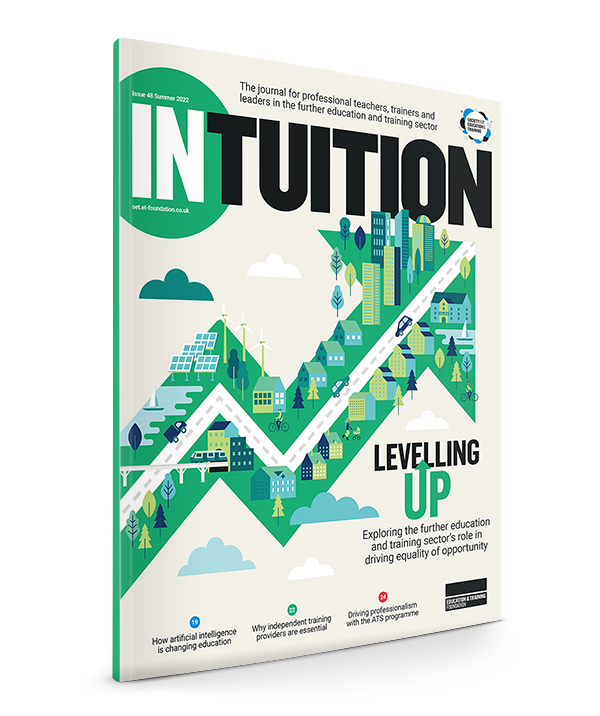inTuition taster: Time for a story
Storytelling can be a useful tool in helping to engage students and bring experiences to life. Wendy Horrex, FSET, QTLS, set out to look at this in the field of teacher education and found it could have a powerful effect on the development of skills that would later be needed in the classroom.

Dialogue is widely recognised as a central tenet of teaching (for example, Alexander, 2008), but my research set out to investigate key features of dialogue in teacher education, specifically teacher education in the further education (FE) sector.
One of the findings was that storytelling was a frequently employed and much-appreciated tool in teacher education. In many teaching situations, storytelling would be classed as monologic, with the teacher expertly weaving a narrative, often drawing on their own vocational expertise to engage students and to illustrate an abstract concept or principle.
In the development of teaching skills, including in teacher education, student teachers were able to develop the skill of storytelling. Stories were more than simply a learned skill, as they also offered strategies for entering the teaching community and for managing the demands of the role.
Savvidou (2010) studied a professional development project in which teachers’ stories were videoed and uploaded to a digital platform, where other colleagues could respond with a story of their own. She conceptualised storytelling as interactional – a reflective dialogue in which participants connected a story to another, echoing phrases and words. They used questioning and development of meaning to draw conclusions, which allowed for construction, or reconstruction, of professional knowledge.
For learning purposes, storytelling needs to be accompanied by questions and probes to promote engagement and reciprocity
This was the nature of the storytelling that was observed in the classroom in my research, and which participants (teacher educators, student teachers and mentors) considered to be of real value to student-teacher learning. Its value was in terms of content, such as to illustrate theory and practice, but also of process, as student teachers found their teacher voice and became legitimate participants in the teacher community.
The telling of stories was observed to be a dialogic process. In this context, narrative or storytelling was conceptualised as the relating of an experience – what Segal refers to as “small stories” (2019, p. 1) by nature of their brevity and being embedded in everyday interaction.
Personal experience
While storytelling is valued in many different phases of education, in the teacher education programme it had several distinct features that related directly to the characteristics of the student group and the learning context. In my research in a FE setting, student teachers brought a rich life history including vocational experience and expertise.
Even at the start, student teachers related tales of their experiences in education, often from a learner, parent or support staff perspective. But as the programme progressed, they increasingly shared stories of teaching in their placement, matching the stories told by their lecturers and mentors.
The fractured nature of the sector they were entering meant that generalisations and textbook answers could sometimes seem unhelpful, whereas stories allowed them to capture “the complexity, specificity and interconnectedness of the phenomenon with which we deal” (Carter, 1993, p. 6). In teacher education, storytelling emerged as a form of dialogue in that it was reciprocal.
In the research, data was collected with a cohort of teacher education students, following them through an academic year. These included observations of taught classroom sessions and mentor meetings; interviews with students, educators (lecturers and tutors) and mentors at the beginning and end of the programme; and documentary evidence in the form of classroom resources, learning journals and recorded reviews. Analysis of the data identified four areas in which storytelling contributed to the learning process for student teachers.
Storytelling for learning: linking principles and theory to practice
Students and lecturers alike told stories to illustrate application of theory to practice, a form of dialogue evident in the structured classroom sessions and in the students’ conversations before and after taught sessions.
Example 1: When discussing the Black and Wiliam report Inside the Black Box (1998) in the early weeks of the learning programme, one student told a story of a lesson she had observed and ways in which she had noticed the teacher using feedback of the type described in the report. The lecturer commended the student’s layering of the theory onto an episode that she had witnessed. In a later session, one of the students told a story illustrating how she had very naturally used this approach in her own teaching, effectively integrating theory with her practice.
Example 2: Where a student had not yet had a particular classroom experience, the stories told by peers and by tutors and mentors allowed a vicarious experience, which helped them to prepare for those situations. Where a whole cohort had not yet had specific experiences, such as being part of an Ofsted inspection, tutor stories were coupled with student stories from a different stakeholder perspective (such as a parent or governor) to gain valuable insights.
Storytelling for debate and argumentation
Exchanging stories allowed student teachers to offer different, sometimes contradictory perspectives, as they were sharing experiences rather than directly challenging an opinion.
Example 3: In one session, a student described how she had carried out a classroom assessment and the lecturer suggested a way that it could have been done differently. The student went on to describe more details of the story, giving more information about the particular circumstances and justifying the approach she had taken. The lecturer agreed that, in this context, it was an appropriate action. The storied nature of the debate meant each could discuss from their own experiences and perspectives, without a direct challenge to the beliefs or values of the other.
Storytelling for participation in the community of practice
As student teachers matched stories from lecturers, there was evidence of becoming part of the teacher community. When interviewed, students and mentors reflected on the way students had become part of the staff room community as they shared stories with colleagues in their placement teaching teams. Notably, storytelling was a valuable part of students’ informal conversations, not only in the taught sessions but with tutors and in their placement staff rooms, and as they participated in extracurricular activities within their placements.
Example 4: One student reflected on the value of what she referred to as “chit chat” with her tutor as she could see parallels between her own career path and that of her tutor, revealed through the exchange of stories that each told.
Storytelling for reassurance and wellbeing
Relating stories could be a way to manage the stresses of the classroom, and to experience peer support as student teachers shared tales of their early teaching experiences. This was particularly important when formal support structures of the learning programme were stretched.
Example 5: One lecturer reflected on the way that storytelling offered student teachers a sense of validation of their own similar experiences and reassurance, which is essential to wellbeing in a challenging role.
These findings reflected the work by Segal (2019), who suggested that storytelling can be a tool in terms of identity (social positioning), of representing practice, and for argumentation.
Use of Activity Theory¹ to analyse the data led to a further finding that storytelling was not only a tool in the activity of the teacher education programme, but an object of it. Storytelling on the teacher education programme was beneficial in the here and now, but also allowed practising of this skill for situations that students would encounter throughout their teaching career.
Mentor and tutor feedback to student teachers commended them on their use of storytelling in observed practice teaching. In this sense, stories were mediators of learning, but students’ use of storytelling was also an object of learning.
Wider implications
How can these insights into the value of storytelling be of use to teacher educators? For the teacher educator, the study revealed that students valued the dialogic nature of storytelling for learning, being given the opportunity in the classroom and in tutorials to share narratives about what they had observed or what they had done. Tutors, lecturers and mentors who made time for this, and asked questions to prompt appropriate use of student storytelling, indicated that this was very worthwhile in achieving multiple objectives.
When teaching complex theory and principles in teacher education settings, telling stories can make those ideas more accessible and relevant. Offering opportunities for reciprocal stories for students to respond to can demonstrate the processing of these ideas in their own context.
Segal’s (2019) ethnographic study of storytelling between teachers suggested that substantive engagement was more prevalent when the story related to a problem rather than success; stories of success were not subjected to reflective analysis by colleagues in the same way. For learning purposes, storytelling needs to be accompanied by questions and probes to promote engagement and reciprocity, not just related for positioning purposes.
Caution needs to be expressed about the risk of developing a kind of folk pedagogy from a single story: teacher educators and mentors need to relate student stories to wider principles to ensure that single-occasion anecdotes are not given disproportionate warrant in developing teachers’ knowledge.
For a student or new teacher, the telling of stories to peers, tutors and mentors can help to master this skill so they can use it in their own classroom to build relationships with learners and bring meaning and application of the wider principles that they are teaching. Opportunities to practise this skill in the teacher education classroom can prepare student teachers for using it effectively in their own teaching.
Student teachers shared stories of teaching in their placement, matching the stories told by their lecturers and mentors
Across the wider teaching community, storytelling helps new teachers feel a part of their profession. Community is based on shared practices, shared identity, shared language and shared goals. Being able to participate in reciprocal storytelling gives student teachers an entry to this community.
Rex (2011, p. 6) summed this up: “For pre-and in-service teachers, narrative is a way of becoming and being professional. They talk and think in story.”
References and further reading
Notes
¹Activity Theory represents activity as a mediational triangle: the subject acts on tools and artefacts in order to realise an object
References
Alexander R. (2008) Towards dialogic teaching: Rethinking classroom talk. 4th edition. York: Dialogos UK.
Black P and Wiliam D. (1998) Inside the Black Box. London: King’s College London, School of Education.
Carter K. (1993) The place of story in the study of teaching and teacher education. Educational Researcher 22(1): 5-1, 18. Available at: doi.org/10.2307/1177300
Rex L. (2011) ‘Introduction. Narrative discourse analysis for teacher educators: Considering participation, difference and ethics’. In L Rex and M Juzwik (Eds.) Narrative discourse analysis for teacher educators: Managing cultural differences in classrooms. New York: Hampton Press, pp. 1-29.
Savvidou C. (2010) Storytelling as dialogue: How teachers construct professional knowledge. Teachers and Teaching 16(6): 649-664. Available at: dx.doi.org/10.1080/13540602.2010.517682
Segal A. (2019) Story exchange in teacher professional discourse. Teaching and Teacher Education 86(102913). Available at: doi.org/10.1016/j.tate.2019.102913
Wendy Horrex, FSET, QTLS, is a trainer in professional development at Eastern Colleges Group.

Find out more about inTuition
inTuition is SET’s quarterly professional magazine supporting members' access to CPD resources and the latest sector and research news. It combines sector news with educational research and exciting practical developments and ideas in education and training.
Find out more


